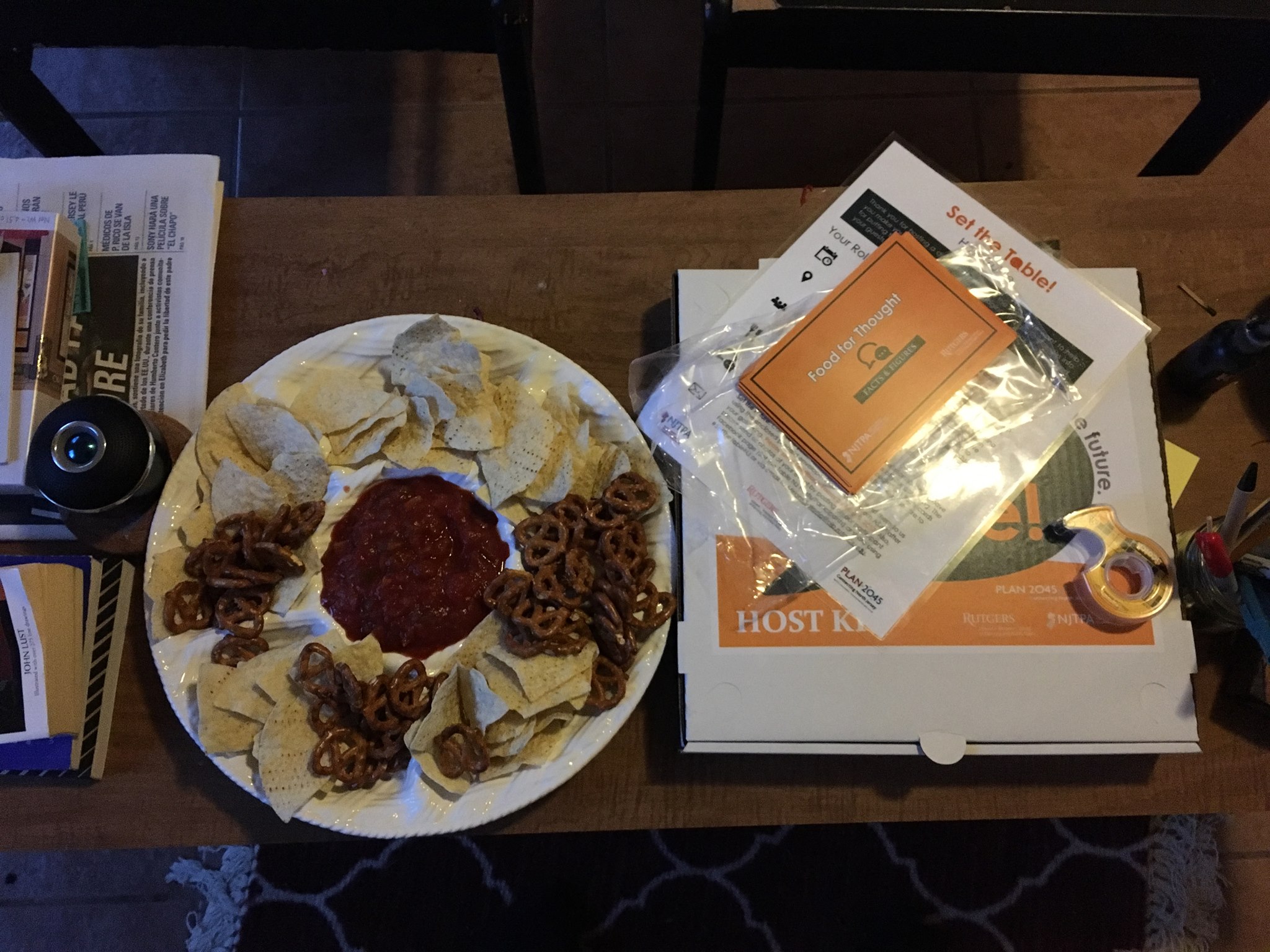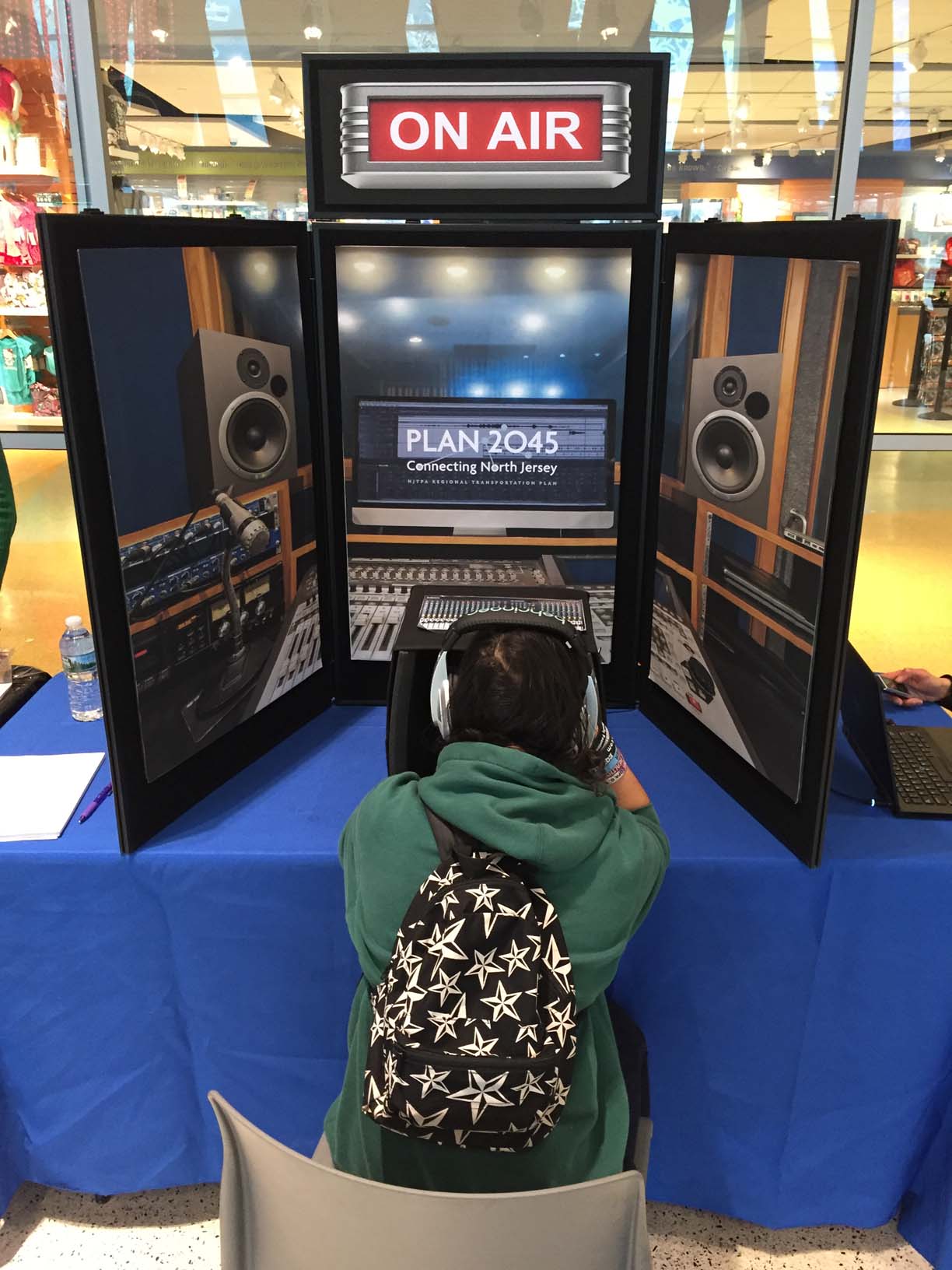 A group of young adults is gathered in a living room. The coffee table is covered in snacks and colorful paper cards. It looks like an informal dinner party, but it’s actually a creative take on public outreach for a long-range transportation plan.
A group of young adults is gathered in a living room. The coffee table is covered in snacks and colorful paper cards. It looks like an informal dinner party, but it’s actually a creative take on public outreach for a long-range transportation plan.
The cards serve as conversation starters, with questions and facts about an array of topics: great places, technology, economy, safety, environment, resiliency and getting around.
The informal gathering of 20-somethings was part of the North Jersey Transportation Planning Authority’s (NJTPA) innovative public outreach for Plan 2045: Connecting North Jersey. The initiative, called Set the Table, recruited 20 young adults to host gatherings with their friends and peers to discuss the region’s current and future transportation needs and provide feedback to the NJTPA. It was one of four specialized outreach programs a team of public outreach specialists from the Alan M. Voorhees Transportation Center at Rutgers, the State University of New Jersey, developed with the NJTPA.
The specialized outreach targeted four specific groups —low-income residents, limited English speakers, young adults and children. It supplemented a separate effort by the NJTPA to gather input at community events and public meetings in its 13-county region.
“We wanted to make sure that everyone was represented in our plan,” said NJTPA Executive Director Mary D. Ameen. “Low-income residents and limited English speakers often can’t make it to traditional public meetings, so we took the meetings to them. And we wanted to make sure younger people were included, too, because they’re the future transit riders and they will be using the new technologies that are emerging.”
When it comes to public outreach, there is no one-size-fits-all approach. Miriam Salerno, a senior public relations specialist and head of the Public Outreach and Engagement Team at the Voorhees Center, said the key is to know your audience and develop an outreach program that caters to the people you’re trying to reach.
“How you tell your story to them really matters,” Salerno said. “Think about it like a production. You’re producing something that you want your audience to respond to.”
In addition to Set the Table, the three other specialized outreach programs were: NJTPA on Air, a portable radio booth, created to gather feedback from children about their vision for transportation in the future; a customized curriculum to get input from adults participating in English as a second language programs; and a partnership with community groups to develop informal events to gather ideas from low-income residents.

The NJTPA had a lot of unique and specialized outreach techniques to draw from. The team from the Voorhees Transportation Center was already working with the NJTPA on a project to research innovative outreach strategies —from looking at what other planning organizations and transportation agencies had done; to conducting focus groups; interviewing implementers of innovative techniques; and working with a class of graduate students at Rutgers’ Edward J. Bloustein School of Planning and Public Policy. All of this work was compiled into an online public engagement resource called Engage! (njtpa.org/engage).
Set the Table was modeled after a civic dinner party program that the Atlanta Regional Committee, a MPO in Georgia, developed. The commission has a Millennial Advisory Panel and over a four-month period in 2015, members were asked to host dinner parties with their neighbors and peers to gather input on three major topics in the Atlanta metro-area: world-class infrastructure, competitive economy and healthy, livable communities.
For Set the Table, each of the 20 hosts was given $100 budget for food and a specially-branded pizza box filled with conversation cards, comment forms, some snacks, and other materials. The hosts took notes and returned them to the NJTPA so their input could be incorporated into Plan 2045.
Initially it was difficult to recruit participants, but once word started to spread, more people wanted to get involved, Salerno said. She said having a “meeting in a box” that was well branded also helped make the program a success.
“It looked really polished,” she said. “I think that’s something the hosts responded too. They felt like they were part of something important.”
The initiative was so successful that the NJTPA is exploring creating a young adult advisory committee.
Another outreach program captured the views and voices of children. Rutgers got the idea after hearing about public listening booths that allowed people to record responses to questions. They created a radio booth and took it to public libraries and museums. Children listened to a short introduction and prompt—recorded by a child —and then recorded their response.
The question was framed in terms they could understand: “Today you probably get around in your family’s car, or maybe you walk or ride your bike or even take public transit like a train or bus. In the future how we get around may look totally different. So, please, tell us what do you think transportation will look like in the future —say when you’re like your parents’ age.”
Salerno said the exercise proved to be most successful with children between the ages of 10 and 15. Younger children wanted to listen to the broadcast, but didn’t have much to say in response and older teens were less willing to participate.
For limited English speakers, the outreach team partnered with English as a Second Language classes.
“The instructors are always looking for new content and an opportunity to teach their students how to talk about real world issue and introduce new vocabulary,” Salerno said. “It was really a win-win for both the schools and us.”
Salerno said the classes allowed people of all languages to participate and the teachers were able to help translate when needed. She said intermediate and advanced classes worked best because they didn’t need the teachers to translate as much.
“Intermediate students had enough vocabulary to understand the concepts and respond,” she said.
To reach low-income residents, the outreach team relied on already-established relationships with community based-organizations that work with them. While the outreach technique wasn’t as innovative as some of the others, Salerno said using trusted organizations gave the outreach credibility and got people to participate.
The key in all of these cases was thinking about the best way to reach each group, she said.
“I think that knowing your audience really matters because that’s your key to varying your approach in a way that makes sense,” she said. “What are different types of people going to respond to both in where you go physically and what you have to do, but also in how you ask the questions.”